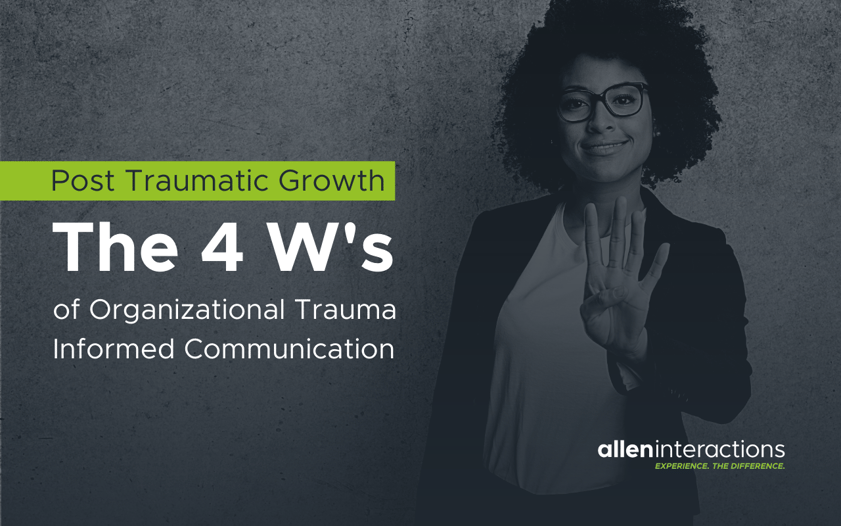Blog
Post-Traumatic Growth: We Answer Your Questions
We live and lead in a time of chronic crisis, swimming upstream in an unyielding wave of stress inducing events. Circumstances change quickly and ...


Post-Traumatic Growth: The 4 W’s of Organizational Trauma-Informed Communication
By Dr. Christina Barss | November 30, 2020 | Strategic Consulting | 0 Comments
We live and lead in a time of chronic crisis, swimming upstream in an unyielding wave of stress inducing events. Circumstances change quickly and often, making communication during a mass scale crisis not a simple, linear activity. Thriving during this time requires leaders to deftly shift their communication strategies, priorities, and tactics.
In this blog, we will:- Focus on how mass scale crisis (i.e. global pandemic, civil unrest, etc.) may impact an organization's collective understanding of the world around them
- Explain how clear communication is key to creating stability in an unstable work environment
- Explore how leaders may identify and address employee behaviors and beliefs as organizational distress occurs
Evolving Leadership Behaviors
Leading through chronic crisis requires whole person thinking, remaining approachable, and being transparent. Using your emotional intelligence skill set at this time increases the opportunity for greater psychological safety and possibly decreases impact of post-traumatic stress, secondary/vicarious trauma, and systemic trauma.
Finding balance during the crisis, especially early, is critical for establishing a compassionate communication plan. Often, beyond necessary emergency communications, leaders instinctually keep to operational 'task completion' and 'safety plans' which are tangible, measurable, and easiest to discuss. The leadership risk is missing the opportunity to meaningfully connect with your team members. Recognize that this is a transformative time for your organization, employees, and community. As about the health and well-being of your team members - it 'gives' you permission to feel differently and be candid.
Trauma-informed communication seeks to balance the tangible and non-tangible, acknowledging the physiological and psychological cost incurred by those continuing to work in this 'newest normal'. Be clear and approach all communication with an abundance of caution. Research exists that compassionate leaders perform better and foster more loyalty and engagement by their teams. There is a delicate balance between being a beacon of hope and a floodlight of authoritarian tasking. Practice patience and grace, stay open during times of stress, authentically express emotion, and rise to inspire and motivate your teams.
4 W's of Trauma Informed Communication
Minimizing the impact of organizational stress and anxiety to your customers and bottom line is possible through an intentional communication process. This intentionally encompasses both operations and humanity. The 4 W's of Trauma Informed Communication considers how the context, content, modality, and frequency of information is shared with employees and others.
1. Why are we communicating?
This is your opportunity to tell your employees how they are valued and what their role is during this difficult time. Providing framing and context to crisis communication empowers employees to make appropriate choices.
2. When is a good time to reach all employees?
Consistent schedule of communication creates a sense of stability and predictability which can be soothing during unstable times. Be inclusive by considering off shifts, weekends, dispersed locations, and time zones when crafting a communication schedule.
3. What and how much information is most important to share at this moment?
During times of high anxiety and stress, attention spans are limited, and communication fatigue is possible. Avoid information overload by delivering information in digestible portions.
4. Where may you always store critical information so it is accessible to all employees?
Stable and predictable access to most recent updates is critical for your organizations safety. Use multiple delivery modes to ensure inclusion across all levels and locations.
.png?width=795&name=Services%20-%204Ws%20of%20Trauma%20Informed%20Communication%20(2).png)
In Summary
A well thought out multi-layer approach for crisis communication enables leaders to be flexible during ever-changing circumstances. The balance of operations and humanity is important in the recognition of organizational transformation. As leaders, acknowledging that grief, shock, and possibly depression, will prevail as employees experience a lost sense of security and normalcy. Now, more than ever, your visible presence in these circumstances becomes an act of caring and concern. Practicing patience and grace, leaders can help your organizations rise to regain control and work through the psychological toll of organizational trauma.
Key Takeaways
- Organizational communication during crisis is not a linear activity.
- Plan a multi-prong approach for crisis communication: What, When, Why, and Where that focus on both operations and humanity.
- Practice patience and grace, stay open during times of stress, authentically expressing emotion; rise to inspire and motivate.
- Recognize that this is a transformative time for your organizations, employees, and community.
View our upcoming courses, webinars, and conferences!

About the Author: Dr. Christina Barss
Dr. Christina Barss is an experienced industry subject matter expert in improvement sciences and organizational culture change. Her unique blend of practical, academic, and art perspectives creates custom operational and employee engagement solutions that transform the bottom line. For example, her PhD in sustainable systems design focused on disparately located interprofessional teams in transition during lean transformation at a large, midwestern, urban, academic medical center. Dr. Barss' 12 years in healthcare were filled leading strategic enterprise-level initiatives to improve patient safety, quality, service, and innovation as well as teaching and coaching executives. From C-suite to frontline, she connects seamlessly and guides others in building trust bridges. Her continuous improvement science foundation began in the manufacturing industry. She presents nationally and internationally on design thinking, change management, organizational culture, corporate learning, executive education, and succession planning.
Comments
Would you like to leave a comment?
Related Blog Posts

By: Dr. Christina Barss | Jan, 2021
Category: Strategic Consulting
%20(2).png?width=316&name=Blog%20-%20Three%20Questions%20Answered%20About%20Post%20Traumatic%20Growth%20(PTG)%20(2).png)
Blog
Three Questions Answered About Post-Traumatic Growth (PTG)
We live and lead in a time of chronic crisis, swimming upstream in an unyielding wave of stress inducing events. Circumstances change quickly and ...
By: Dr. Christina Barss | Nov, 2020
Category: Custom Learning

Blog
Using Change Management Models to Grow Organizational Success
We live and lead in a time of chronic crisis, swimming upstream in an unyielding wave of stress inducing events. Circumstances change quickly and ...
By: Dr. Christina Barss | May, 2020
Category: Custom Learning, Strategic Consulting

